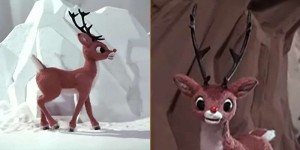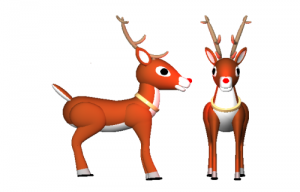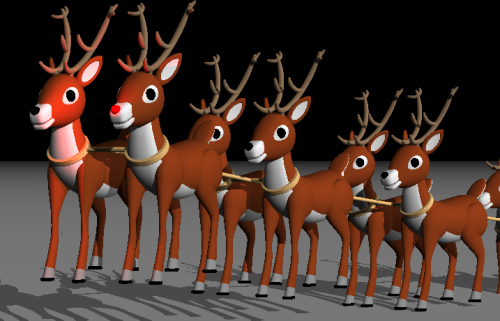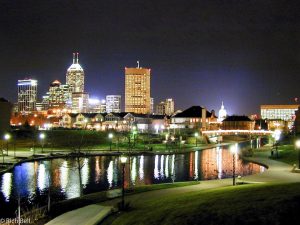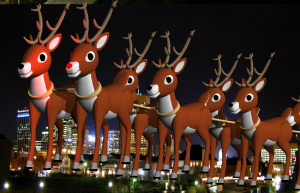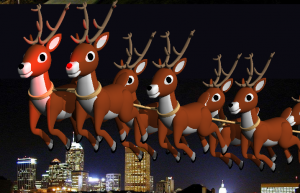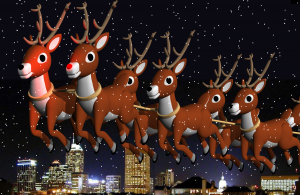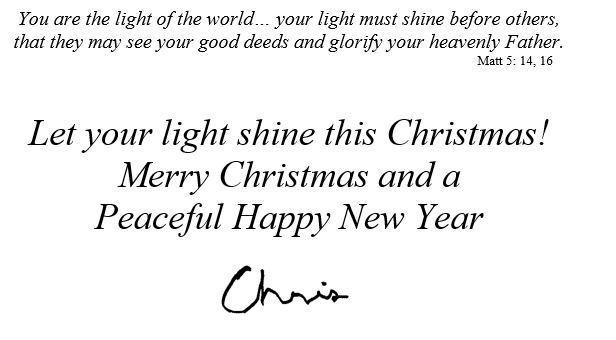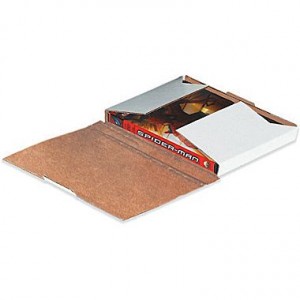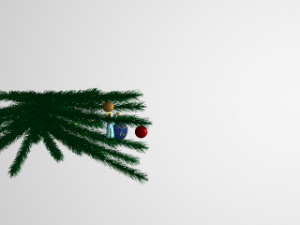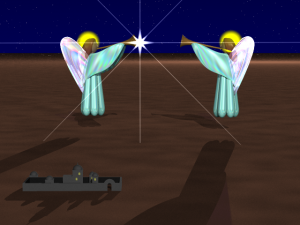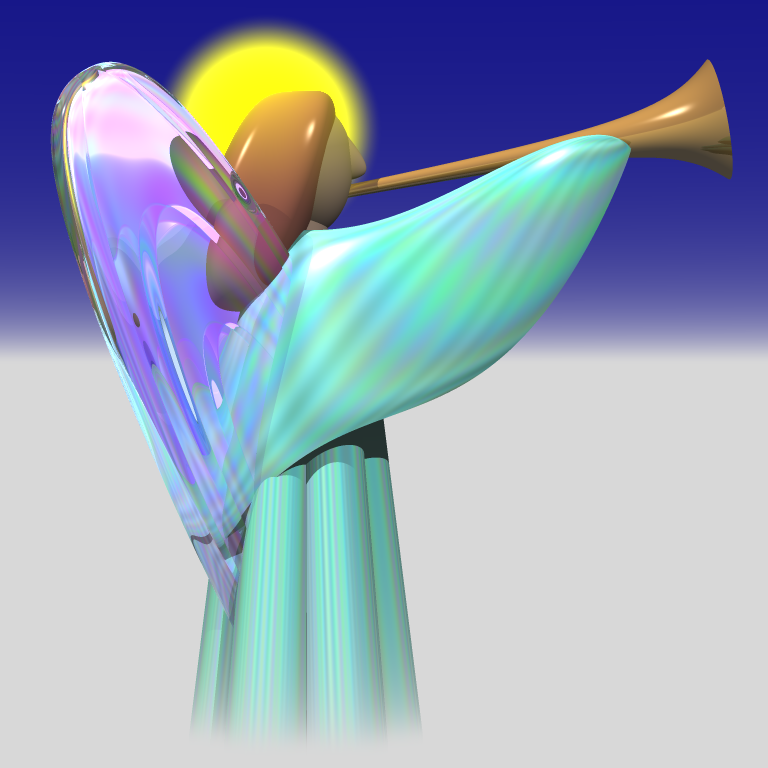Each year it’s a challenge to come up with a new design for my famous ray-traced computer-generated Christmas cards. Sometimes when I run out of ways to outdo myself from a previous years card I come up with a gimmick. For example in 2010 when I had just purchased a new 3-D TV I decided to make a 3-D Christmas card. I rearrange the figurines in an older card that showed a nativity scene and rendered it in 3-D. Each card came with it on set of red/blue anaglyph 3-D glasses for viewing. I also made an animated version where the camera moves in and around the scene. It was a little video clip that I could show on the 3-D TV. Click here for a YouTube version.
This year I was totally stumped on what to do next. I’ve done almost all of the religious themed cards that I could think of. I’ve done Mary and the Child (1997). The Three Kings (1998). Shepherds and Angels (2002). Mary and Joseph and Child (2001). Mary and Joseph and the Innkeeper (2003). I’ve done various Christmas trees some close-up with just a few ornaments (1996). An entire decorated Christmas tree (2006). Then I did a Christmas stocking (2007), a fireplace with multiple stockings (2008). In 2011 I had my most complex card ever been included a Christmas tree, fireplace and stockings, a dining room table with Christmas decorations including a china cabinet in the background full of plates with various patterns on them. Last year I did a close-up of the same table Christmas ornaments hanging in a cone shape that resembled a tree. There just isn’t much else to do. Here is a link to a Facebook album showing all of my computer-generated Christmas cards.
The only area of Christmas that I haven’t explored is more of a kid’s theme with Santa Claus, reindeer, snowman etc. So I decided that was the road I needed to explore next. However except for a small Santa figure on the dining room table scene, I had not created any objects from this genre. One of the things that makes these cards easier to make your after year is that I can reuse models and reincorporate them year-to-year.
Perhaps it was time for another one of my gimmick cards that reflects what’s going on in my life currently. If I look back over the past year the thing that is occupied my life most is taking up the hobby of electronics. I built multiple gadgets using Arduino-based microcontrollers and I have the little credit card sized computer known as the Raspberry Pi which I’ve been playing with.
There is a company called Bare Conductive that makes electrically conductive ink and paint. They sell little kits where you can make greeting cards that have blinking LEDs and tiny button sized batteries. You connect the LEDs to the batteries using their special electrically conductive paint. They have a card that shows Rudolph the Red Nosed Reindeer with a blinking red nose but it is a horribly stylized design that I thought was really unattractive. In addition to selling kits for single cards, they will also sell you a package of 50 LEDs and 50 batteries along with a paint pen for drawing the lines. So I ordered a tube of paint and the LEDs and batteries and started work on my own version of Rudolph.
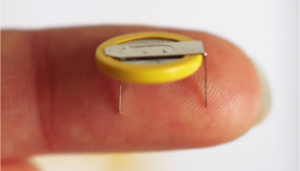 |
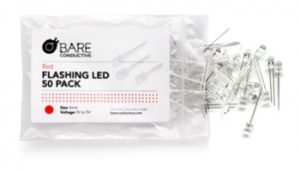 |
I needed some reference images to design my reindeer. I decided I wanted him to look like the stop motion animated figures from the 1964 Rankin/Bass produced TV special which is still erring even this year. I got a copy of the TV special and did some screen grabs. In the early part of the show Rudolph is very young and has not yet grown antlers. Halfway through he grows up into sort of a teenaged reindeer. He has a good set of antlers but they are not as full as some of the other reindeer. Here are some of the reference images that I used in designing my model.
I wanted more than just Rudolph although I could have put him on the ground in the snow perhaps with Santa and some elves standing around. However one of the nice things about creating these computer models is it’s easy to duplicate them. Once you’ve got one reindeer it’s a snap to make eight or nine. I had so much difficulty modeling the antlers the way I wanted them that I didn’t feel like making a different set of more mature antlers for the other reindeer. (You can click this image for a larger version as well as other images in this blog.
One problem was that the LED is relatively big when you think about sticking it on the nose of a reindeer. If I filled the scene up with too many other things, Rudolph would be too small and his nose would be gigantic. So I had to make the Rudolph character be the primary ature in the scene. I did some test renderings with eight reindeer and Rudolph in the front row. It turned out I really didn’t have room to create a sleigh with Santa and a bunch of toys. So it turns out that the sleigh is sort of off the edge of the screen not visible just implied.
Then I had to figure out what to do for a background. I could have just done a plain white background and had them sort of abstract. But I really wanted to create a full scene. It would be easy to create a night sky perhaps with stars or snowflakes but I wanted to give it some perspective so I needed a ground scene. It would’ve taken me weeks to come up with a bunch of tiny houses or buildings covered in snow on the ground extending to some horizon. My friend Rick Ruiz suggested maybe a photo background. I started doing Google image searches for nighttime Indianapolis skyline. I needed something that was recognizably Indianapolis but have lots of sky. I finally found the following image.
Unbeknownst to me, this image was a copyrighted photograph by photographer Rich Bell. I do not recall where I obtained the image but it did not contain any visible copyright notice. I did not bother to check the metadata and after resizing and manipulating the image the metadata was lost. In 2016 my use of the image was the subject of a copyright infringement lawsuit brought against me by Mr. Bell. We eventually settled the dispute and of court for undisclosed terms. The image shown here is a legitimate licensed version of the image. Although I believed that my use of the image constituted “fair use” under copyright law, it would’ve cost me thousands of dollars of legal fees and over 18 months in federal court to see the case through to its ultimate conclusion. There is a public perception that anything on the Internet is fair game but it most certainly is not. Any content creator wishes to aggressively pursue their rights under the law may do so. Let my story serve as a cautionary tale. I will have more to say on the topic in a separate blog post at some point.
I had to extend the sky higher and clip off the bottom of the image that shows the city lights reflected in the canal. Now that I had decided that the reindeer would be in flight over the city rather than standing on the ground I had to remodel their legs to put them into more of a swept back flying position. Also my original design had been flying from left to right but the way the buildings were arranged in the skyline I had to flip the reindeer around so they were flying right to left.
I still have the problem that the legs of the reindeer were partially blocking the skyline. I had to keep moving the skyline image lower in the scene, adding more black space at the top. One of the problems was that the shorter buildings such as the state capital were disappearing off the bottom of the card. So I took some creative license and did a cut and paste to move the capital dome and some of the other buildings on the lower right up higher in the image. It doesn’t mess up the perspective too bad.
Here is the final image.
I sent the image off to VistaPrint.com to have them printed and soon the parts arrived from Bare Conductive to add the LEDs. We experimented by connecting an LED to one of the tiny button batteries and we let it sit to see how long it would run. After about three days it was still going but it was very very dim.
I generally try to put some sort of Scripture quote on the inside of the card along with a Christmas greeting. I came up with the theme of letting your light shine on Christmas and immediately thought of The Sermon on the Mount where Jesus says to the believers “You are the light of the world… Let your light shine…” So here’s what it looks like on the inside of the card.
The examples they show on the Bare website show you how to use a little flap of paper to make a switch. You leave a gap in the circuit and then coat the flap with the conductive paint. As you hold close the flap it completes the circuit and the LED lights up. The nice thing about these LEDs is that they don’t require any other circuitry or resistors. They just blink on their own. Here are some images of my circuit.
One of the big problems all along in this project was deciding how I was going to mail them. Almost half of them would got people that I see on a regular basis and so I could just hand-deliver them. But many of them are out of town or are people who I don’t see very often in town and would need to mail them. I asked a photographer friend if he knew where I could get boxes that were the size of a 4 x 6 photo since that was the size of the greeting cards. He told me that everything is digital these days and photographers mostly just give the client a Photo CD other images and perhaps a few big prints. One company that made boxes for photos had gone out of business.
After doing some Google searches I realize that boxes made for mailing DVDs would be just about right. I’m not talking about flat envelopes were padded envelopes. These were boxes for mailing a boxed DVD. The post office has some that are just the right size and you can get them for free but you have to mail them using priority mail. That was likely to be more expensive. I finally found almost the same thing at Staples.com at a reasonable price and so I ordered them. Later that same day I got a phone call saying that they were out of stock and I could reorder in a few days. They did not offer to put them on backorder for me.
 I went ahead and ordered the priority mail boxes from the post office. Then I started figuring out the price. If I could go regular first-class I could mail a 2 ounce box for a little over two dollars. But if I was going to mail priority mail it was going to cost me five dollars each! I suppose I could have taped over the “Priority Mail” logos all over the boxes and disguised them but that was probably a federal offense.
I went ahead and ordered the priority mail boxes from the post office. Then I started figuring out the price. If I could go regular first-class I could mail a 2 ounce box for a little over two dollars. But if I was going to mail priority mail it was going to cost me five dollars each! I suppose I could have taped over the “Priority Mail” logos all over the boxes and disguised them but that was probably a federal offense.
I tried looking at Office Depot and Office Max and they had something similar but they would only sell them in packages of 50 and they cost $30-$33. Out of the 30 or so LED cards I was making, I had narrowed it down to only 13 or 14 bit to be mailed. By the time I had paid a high price for 50 boxes, the cost per card was back up to the point where it was similar to the free boxes and the priority mail postage costs. I tried reordering at Staples a few days later we got the website said “in stock”. Unfortunately two days later I got an email saying “sorry they are out of stock”. So we are going ahead with the priority mail postage.
I generally send about 65 or 70 Christmas cards each year. Because I was worried that we were going to ruin some, I went ahead and ordered 100 cards even though I could’ve ordered 75. It was a good thing because we did run a couple of cards and I always come up with some people I want to send to at the last minute.
Because dad was going to be the one to have to assemble all these LEDs and batteries and little paper flap switches and because I didn’t want the costs to get too big, I picked out about 30 people who are family and my closest friends to get the special edition. The other 30 people will get a plain Rudolph Christmas card without the LED. (Shhhh… don’t tell them).
We also ruined a couple of cards because after we had them assembled we discovered that my package of 50 red LEDs actually contained five or six green LEDs! When these LEDs are not illuminated they look completely clear so you can’t tell what kind they are. Somebody messed up at the factory. They are going to get an email from me.
Here is a video of what the card looks like with Rudolph’s nose blinking.
Many thanks to my dad who assembled all of these cards, assembled the boxes for mailing, stuck on the mailing labels, and hauled that all off to the post office.
 I had to show off my card so I couple weeks ago I participated in the weekly Adafruit Show-and-Tell video chat on Google plus. Here is a link to that video in which I also showed off some computer-controlled Christmas lights. My segment of this 22 minute video started about the four-minute mark. But the other projects shown that night were really cool as well.
I had to show off my card so I couple weeks ago I participated in the weekly Adafruit Show-and-Tell video chat on Google plus. Here is a link to that video in which I also showed off some computer-controlled Christmas lights. My segment of this 22 minute video started about the four-minute mark. But the other projects shown that night were really cool as well.
Now what the hell am I going to do next year??? I guess I will have to add sleigh, Santa, and some toys and skip the LEDs.
Creating A Ray Traced Angel
Every year since 1995 I’ve created a ray traced, computer-generated image for a Christmas card. But before I created this Christmas cards I created an image that is my rendition of the St. Gabriel the Archangel Catholic Church logo how it would look if it were three-dimensional instead of a line drawing. I’ve created this video to show you the process I use to create such images. Eventually I hope to create a similar video for each one of my Christmas card designs. This angel appeared in my 1995, 1996 and several other cards. It established the visual style for many of the elements of future cards. So when you’ve got about 13 minutes to spare, check out the video embedded below or better yet click here to view it on YouTube in full-screen mode since it is in full 1080 HD.
| See how I turn this… | Into this… |
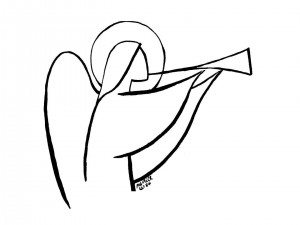 |
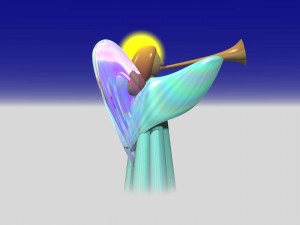 |
Here is the video below.
Ornaments on a Tree 1996
A friend of mine once sent me a Christmas card that showed a can of peas being poured over a globe of the earth. The caption read “Peas on Earth”. This incredibly groan inducing pun was a partial inspiration for this particular image. Also I had obtained an image map that was a satellite view of the earth and so I thought wrapping that image around a sphere would make a nice Christmas ornament. Rather than being “Peas on Earth” or a traditional “Peace on Earth” I put “Peace on Earth” on the Earth.
The image also gave me the opportunity to try out some bump maps to give the ornaments some texture. And of course I wanted to reuse the Gabriel Angel which I thought made a nice ornament as well. Here is my 1996 card
The most difficult part of this image was designing the evergreen branches, positioning them, and positioning the ornaments hanging from them. One of the problems with computer modeled objects is that they have no solid substance to them. Objects can pass through one another even when you don’t want them to. Several early drafts had pine needles protruding into and back out of some of the ornaments. I had to fudge the position slightly. There still may be some needles sticking into the ornaments but it’s not as obvious a mistake unless they suddenly appear poking out the other side.
The silver bells were an interesting challenge. They are part of a cubic equation which is…
x2+y3+y2+z2 =1
One of the problems is that they have a highly reflective surface and there was nothing beside the camera or to either side of the image to reflect. It was just black void. Therefore the entire model was “encased” in a white box with a tan surface behind the image.
I did not actually model an entire Christmas tree in this image (although I would in future images). In 1996 even this small model was pushing the limits of what my computer can handle. There are actually six rows of branches and eight “columns” of branches. I said columns with quotation marks because they are actually arranged radially around a central axis. The images below show a real model at a wider angle and from different directions.
There were messages in both the upper and lower panels of the card as you opened it vertically. They read as follows…
|
Suddenly there appeared with the Luke 2:13-14 |
|
Peace be with you. |
On the backside of the card following explanation of how it was created.
|
This Christmas card was designed and created by Chris Young using POV-Ray 3.0 ray tracing software. No other computer modeling tools were used except a text editor. The model contains over 20,000 objects and consume 15.9 meg of memory while rendering for 7 hours, 28 minutes, 43 seconds on a 100 mhz Pentium. The Angel is a 3-D realization loosely based on a Joanne Austell line drawing which is the logo St. Gabriel Catholic Church, Indianapolis. http://www.iquest.net/~cyoung |
Note that the email address I gave was an old CompuServe email address and my webpage was with local ISP iQuest.net which was the first Internet provider I ever used. That account and page are no longer active of course.
The previous card had a message on the back but it did not say what kind of computer rendered it or how long it took. This one notes that it was a 100 MHz Pentium and I presume that the 1995 card was rendered on the same PC.
The original card was printed on plane card stock not glossy. I cut the stock so that the folded card was 4″ x 6″. In those days you couldn’t buy greeting card stock with envelopes. In order to get greeting card size envelopes I went out and purchased the cheapest ugliest Christmas cards I could find. I threw away the cards and used the 4 x 6 envelopes. The image itself had a quarter inch margin all around making it 3.5″ x 5.5″. Assuming I rendered it at 300 dpi, which was typical in those days, it came out 1050 x 1650. I re-rendered the image using my current Intel i7 quad core under Windows 7 and it ran in just 10 minutes 24 seconds compared to 7 hours 28 minutes on that old computer. On the new machine I cranked it up to 600 dpi which is 2100 x 3300 and it only took 31 minutes: 38 seconds. The speed difference is really amazing.
The image that is uploaded here is a modern rendering. There must’ve been some minor changes in the way POV-Ray handles the halo feature because the halo on the angel is much dimmer than it was on the original image. I haven’t bothered to readjust the source file so the halo comes in brighter and more solid.
In our next installment we will display what is arguably my most beloved image.
My First Ray Traced Computer Graphic Christmas Card 1995
All these blog entries up till now have been leading up to my first real computer-generated Christmas card. This was the cover image on the card.
The card was printed on ordinary 8.5″ x 11″ paper one quarter size with a quarter inch margin. The page was then folded twice to make a 4.25″ x 5.5″ card. On the inside was the following message.
|
“Can it indeed be that 1 Kings 6:27 |
|
“And the Word became flesh John 1:14 Merry Christmas and Happy New Year |
This would be followed by my signature. I actually signed my name one time on a piece of paper, scanned it and turned it into an image which I cut and paste into Microsoft Word every Christmas card since then. So if you get a Christmas card from me in 2013 my signature will look exactly like it did in 1995 because it’s the same image.
The word “Emmanuel” is Hebrew for “God with us”.
While this image looks like a couple of angels in the foreground, the Star of Bethlehem high in the background, and Bethlehem itself on a distant horizon. It is in fact a clever bit of forced perspective. When creating models for ray tracing sometimes it’s important to model the objects at a particular size in order to get the proper lighting effects and texture effects. I also wanted to get the idea that the scene was being backlit by the Star. However with a bright light source in the distance casting shadows forward, the angels themselves were too dark. When I tried shining a light on the front, it illuminated the ground and the Town of Bethlehem too much. I actually ended up creating four spotlights with two each shining on the angels to illuminate them. But there’s more at work here. The “Little town of Bethlehem” is much littler than you think. It is actually a small model sitting in the foreground. Also the Star looks like it is distant with lens flare rays appearing in front of the other objects. In fact Star and the rays are a physical object in the foreground between the Bethlehem model and the angels. In the image below I’ve moved the camera back and up at a different angle to show you what the model really looks like. Sometimes when you’re trying to compose a good-looking image, you just have to fudge it.
We’ve not seen the last of St. Gabriel Angels. It will show up again in the 1996 Christmas card as a Christmas tree ornament. Stay tuned…
It All Started with the St. Gabriel Logo
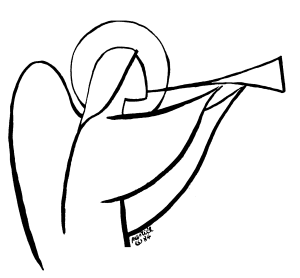
Official logo of St. Gabriel Church Indianapolis originally designed by parishioner artist Joanne Austell
Continuing with my saga of computer generated Christmas cards, before we get into the first card I want to tell you about my ray traced version of the St. Gabriel the Archangel Catholic Church logo. Shown here on the right.
The image was designed by St. Gabriel parishioner and artist Joanne Austell to commemorate the 25th anniversary of the founding of our parish on the northwest side of Indianapolis. I’d always been a big fan of the image and I promoted it and used it wherever I could especially when designing the website for the parish. I wanted to create a three-dimensional looking version of this elegant 2-D line drawing.
The image below is what I came up with. I actually do a very good job of re-creating it to the extent I had hoped. When I was working on it I didn’t have a copy of the logo handy at the time. Somehow I thought original line drawing had a nose on it. I remember it had a very distinctive shape and I spent a lot of time trying to re-create that contour. Unfortunately the contour was remembering was actually the chin of the original drawing. By the time I had completed the image and realized my mistake I had already gotten used to seeing the nose on my version so I kept it. My image actually has no chin at all. I spent a lot of time trying to get the sweep the arms just right. I never was completely satisfied with that but at least it’s closer to the original than the face was.
This angel image would be reused in my 1995 Christmas card as well as several other cards. It also was the basis for this style of all the figures used in subsequent cards. So if I’m going to tell the story of how I created all of those Christmas cards we really needed to show this one first even though it wasn’t a Christmas card.
You can click on the image for a larger version.
At one point I had created detailed video explaining the mathematical formulas behind the various shapes and a sort of step-by-step visual explanation of how I pieced together the geometric shapes to create the image. Unfortunately I never completed the video and part of the files I used to make it (most notably the open captions and the voiceover narration) somehow got lost. I’m going to go back and re-create that video someday but for now you can just enjoy the still picture.
In the next installment we finally get to my 1995 Christmas card.
My First “Computer-Generated” Christmas Card (circa 1976)
Starting in 1995 I begin making Christmas cards using the Persistence of Vision Ray Tracer (POV-Ray) open-source freeware software which I helped create. Using a script of text commands it generates photorealistic three-dimensional images with realistic lighting, shading, shadows and other image effects. I’m going to use this blog to share some of my creations throughout the years however before I start off with the 1995 card, I thought it was important to share with you my very first “computer-generated” Christmas card.
It consisted of some ASCII art spelling out the words “Merry Christmas” followed by a cheesy bit of verse that I composed. The entire thing was printed out on green bar computer pape line printer of the DEC-System-10 computer at IUPUI when I was a computer science student there. An image of the card is shown below but in case you can’t read it, following that is the verse that I wrote (questionably bad punctuation included).
MAY YOUR BIAS VOLTAGE BE EQUALIZED,
AND ALL OF YOUR DIODES GLOW.
MAY ALL YOUR CAPACITORS KEEP THEIR CHARGES,
AND NONE OF YOUR FUSES BLOW.
MAY YOUR PARITY ERRORS BE VERY RARE,
AND YOUR DOWNTIME BE QUITE SHORT.
MAKE YOUR REGISTERS NEVER OVERFLOW,
AND NONE OF YOUR PROGRAMS ABORT.
MAY CHRISTMAS BE AS HAPPY FOR YOU
AS IT WILL BE FOR ME.
THE REASON MINE WILL BE SO NICE
IS I'M PRINTING THIS GREETING FOR FREE.
NOW IF YOU THINK MY CHRISTMAS VERSE
SHOULD BE WITTIER AND CUTER
I HAVE TO SAY "THAT'S NOT MY JOB!
GO BLAME IT ON THE COMPUTER."
IN OTHER WORDS, A VERY MERRY CHRISTMAS AND
THE HAPPIEST OF NEW YEARS FROM –-
CHRIS YOUNG
AND THE IUPUI DECSYSTEM-10
Here are some of the obscure references behind the text.
“Bias voltage” is something that tape recorders use to eliminate background hiss and noise. Rather than having the electricity go plus or minus a couple of volts say from +2v to -2v the recording head adds a bias so that perhaps it goes from +5v to +1v. I don’t know if these values are even in the ballpark of what’s actually used I’m just explaining the principle. In the mid-1970s cassette tapes came in different varieties. The ordinary tapes used “normal bias” and the newfangled metal oxide tapes use something called “high bias”. When you play back the tape, in order to get the best results your playback had to equalize the bias voltage properly. There was little switch you had to throw between high bias and normal bias. I still don’t understand completely what it means but it sounded cool so I included it.
“Diodes glow” in the mid-70s light emitting diodes were relatively new technology.
Capacitors and fuses are pretty straightforward. No explanation needed.
“Parity errors” when computers transmit data over a serial line they generally transmit eight bits at a time but in order to detect mistakes they transfer a ninth bit called a “parity bit”. Parity can be “odd” or “even”. That means in the string of 1s and 0s you add up the number of 1s and see whether you get an odd or even number. If you’re expecting odd and you get even that’s called a parity error. That’s bad news. You want them to be “very rare”.
“Register overflow” computers do arithmetic in special storage places called “registers”. But registers can only store a number with so many digits (or bits). If you try to do arithmetic with two big of a number you get a register overflow error. That’s bad.
“Programs abort” anytime a program stops unexpectedly is called an aborted program. (Bad joke from the archives… I’ve got one of those new “RU-486” CPUs and it’s causing my programs to abort.) ((Explanation of the explanation… Intel made a processor called a 486. However RU-486 was the name of an early “morning after” abortion pill.))
“Free printing” if I had typed up the text and taken it to the library and xeroxed it it would have cost me 10 cents per page. But if I typed it into the computer and told them to print me 30 copies of it, it was free. I had a psychology professor who had discovered this and rather than type up his class notes or handouts and xerox them, he would just put them on the computer. They would print as many copies as he needed to distribute to his students for free. It seemed strange to get class notes from a liberal arts teacher on green bar computer paper but it was pretty smart of him. It inspired me to print these cards that way.
“That’s not my job!” There was a popular TV show called “Chico and the Man” starring the late Freddie Prinze Sr. He was a bright and rising young Chicano standup comic who at the age of about 19 got his own sitcom. He played Chico who worked in an auto repair shop run by cranky old man played by the late great Jack Albertson. Although he talked in plain English most of the time, whenever “the man” would tell “Chico” to do something he didn’t want to do he would throw on a very thick Hispanic accent and say “ezz no my chob mhan”. (It’s not my job). That phrase got to be a pop-culture catchphrase. Tragically Freddie Prinze committed suicide at age 22. He was the father of TV and film star Freddie Prinze Jr.
“Blame it on the computer” is to this day a pop-culture catchphrase.

